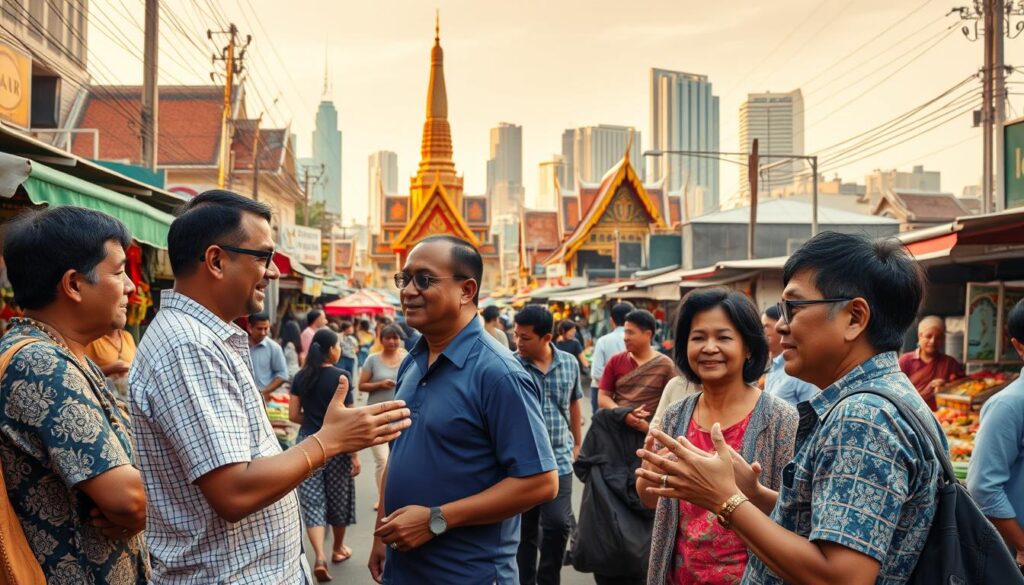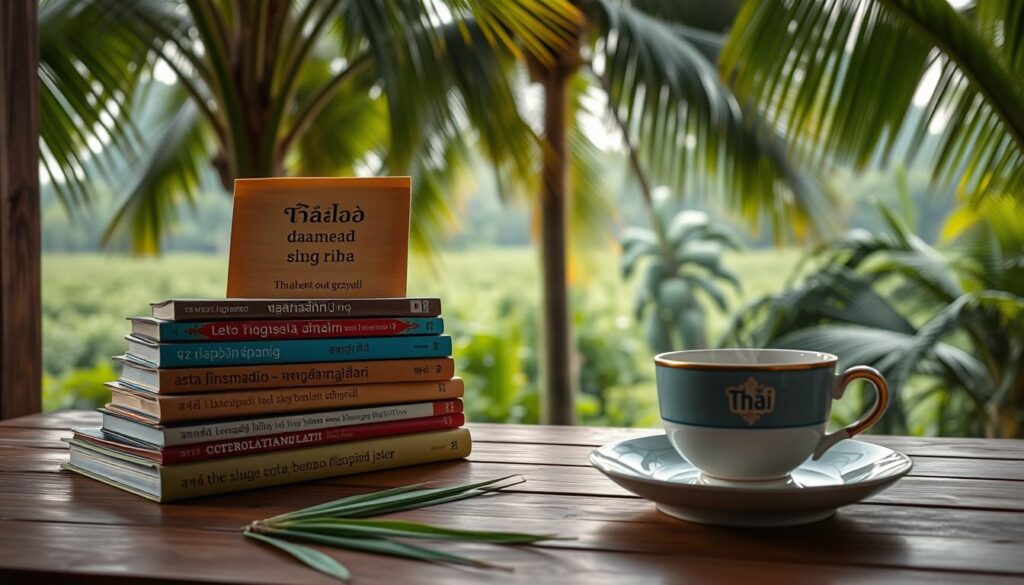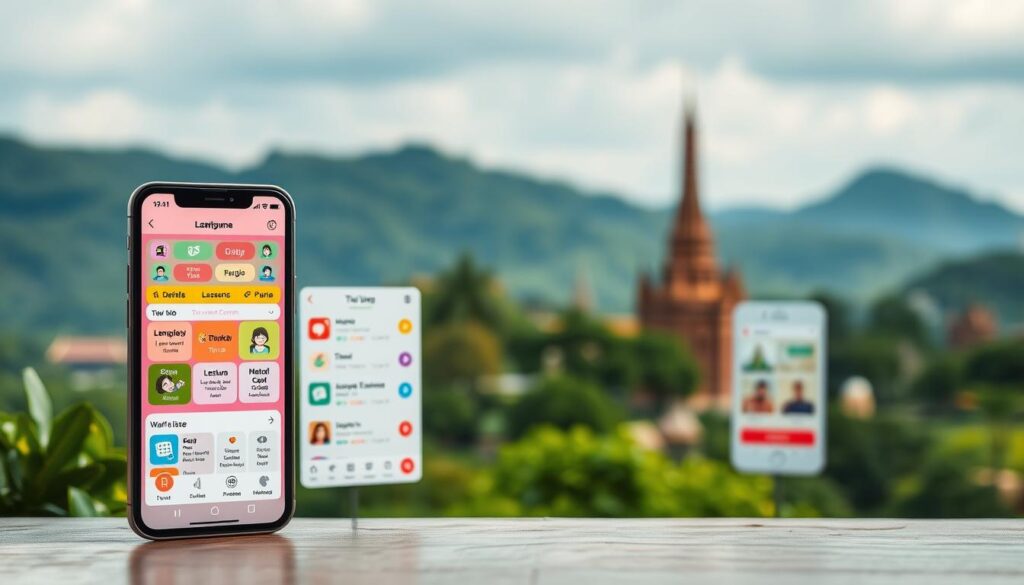Thailand Communication: Language Hacks & Translators
Did you know over 60 million people in Thailand speak a language different from English? Learning the basics of Thai can make your interactions with locals better. It makes your experiences more enjoyable.

Effective communication is key when talking to people from other cultures. Learning a few Thai phrases and using translation tools can help. You’ll find conversations easier and build stronger connections.
Language is a bridge to understanding cultures. Improving your English to Thai translation skills can enhance your Thailand Communication. This section will show you the importance of language hacks and translators in your interactions.
Understanding Thai Language Basics
Getting good at talking in Thailand starts with learning the basics of the Thai language. As you explore English to Thai translation, it’s key to know the special things about Thai talk. Knowing the basics is vital for clear communication, whether you’re visiting or doing business.
The Thai Alphabet and Pronunciation
The Thai alphabet is unique and complex, with 44 consonants and 32 vowels. Learning the Thai alphabet is tough but essential for better communication. Thai is a tonal language, so the same word can mean different things based on the tone used.
Tonal accuracy is key in Thai. The language has five tones: mid, low, falling, high, and rising. Getting these tones right helps avoid mistakes and shows respect for Thai culture.

Common Greetings and Phrases
Knowing common Thai greetings and phrases shows respect and improves your experience. Simple words like “sawatdee” (hello), “khop khun krap” (thank you), and “mai ow hai” (excuse me) make a big difference.
- Greetings: “Sawatdee krap/ka” (Hello)
- Thank you: “Khop khun krap/ka” (Thank you)
- Goodbye: “Sawatdee krap/ka” (Goodbye)
- Excuse me/Sorry: “Mai ow hai/kor toot” (Excuse me/Sorry)
Using these phrases right can make your interactions better and your experience more positive. They’re a great start for more complex talks. They’re also useful when you’re using a digital marketing strategy Thailand to reach more people.
Importance of Communication While Traveling
Exploring Thailand can be much better if you can communicate well. Knowing how to ask for what you need and understanding the local culture makes your trip more fun and less stressful.
Good communication helps you deal with everyday things, like ordering food or getting directions. It also lets you talk to locals, which helps you learn about their customs and life.

Overcoming Language Barriers
One big challenge in Thailand is the language barrier. While many people in tourist spots speak some English, you might sometimes struggle to understand each other.
To get past this, you can use translation apps or carry a phrasebook. Learning simple Thai phrases like “hello” (สวัสดี – sawasdee) and “thank you” (ขอบคุณ – khob khun krap) shows respect for the culture.
Getting help from a local communication agency or guide is also a good idea, for tricky situations or official papers.
Enhancing Travel Experiences
Good communication does more than just help you get around. It makes your trip better by letting you find hidden spots, talk to locals, and have a real experience.
- Learn key phrases to show respect for the culture.
- Use technology like translation apps to aid communication.
- Consider hiring a local guide for complex situations.
By using these tips, you can make your trip to Thailand more fun and memorable.
Essential Thai Phrases for Tourists
Learning essential Thai phrases can make your trip to Thailand better. Knowing a few key words helps you deal with everyday tasks. This includes ordering food and finding your way around.
Useful Everyday Expressions
Starting with basic greetings is a good idea. The Thai greeting, “Sawatdee” (สวัสดี), is used for both hello and goodbye. It’s a great way to begin.
Showing respect is also important. Men say “krub” (ครับ) at the end of a sentence. Women say “ka” (ค่ะ).
For saying “thank you,” men say “Khop khun krap” (ขอบคุณครับ). Women say “Khop khun ka” (ขอบคุณค่ะ). If you need help, saying “Ch่วยเหลือ” (Chway chuay) for “help” or “mai ow hai” (ไม่โอวาทให้) for “excuse me” can be very helpful.

Dining and Shopping Vocabulary
Ordering food in Thai can be fun. You can say “kao niew” (ข้าวเหนียว) for “sticky rice” or “pad thai” (ผัดไทย) for the famous stir-fry dish. If you want to buy something, knowing numbers and basic shopping phrases is useful.
For example, “mai ow hai” (ไม่โอวาทให้) means “how much is this?” and “ngaun” (เงิน) means “money.”
Learning these phrases can also help with marketing communications Thailand and understanding local culture. If you’re into online advertising Thailand, knowing your audience’s language can boost your campaign’s success.
Popular Communication Apps for Travelers
Traveling in Thailand? You can use many communication apps to get past language barriers and stay in touch. Today, lots of apps help make traveling easier and more fun.
WhatsApp and WeChat
WhatsApp and WeChat are top messaging apps worldwide. They have features great for travelers. WhatsApp lets you send messages, make calls, and share files with others. WeChat does more, like mobile payments and booking services, in addition to messaging.
Key Features:
- End-to-end encryption for secure communication
- Group chat functionality for coordinating with fellow travelers or locals
- File sharing for exchanging information or documents

Google Translate Features
Google Translate is a must-have for travelers facing language issues. It has features that make talking to locals in Thailand easier.
Notable Features:
- Text translation in over 100 languages
- Real-time conversation mode for instant translation
- Camera translation to read and translate signs and menus
With these tools, you can talk to locals, read Thai signs, and even translate menus. This makes your trip more enjoyable.
Cultural Considerations in Thai Communication
Cultural factors greatly influence how people communicate in Thailand. They affect both what we say and how we say it. Knowing these cultural details is key to avoiding misunderstandings and forming strong bonds with Thai speakers.
The Role of Non-Verbal Cues
In Thai culture, body language and facial expressions are very important. For example, the wai greeting is a sign of respect. It involves placing your hands together and bowing slightly. The depth of your bow shows how much respect you have for the person.
Other non-verbal cues include:
- Maintaining eye contact, but avoiding direct stares, which can be seen as confrontational
- Using open and approachable body language
- Being mindful of your feet, as pointing them at someone is considered rude

Respecting Hierarchy in Conversations
Thai society values hierarchy and respect for authority. This is seen in the language used, with different words for different relationships. When talking in Thailand, knowing these hierarchies is important.
For example, when talking to someone older or in authority, use respectful language. Say “Khun” followed by their name. This shows you respect their position.
By understanding and respecting these cultural aspects, you can improve your communication in Thailand. This will help you build stronger connections with the people you meet.
Tips for Learning Thai Efficiently
Now, you can learn Thai more easily than before. Talking to native speakers is key. It helps you learn real speech patterns and local sayings.
Language Learning Apps and Resources
Many apps and resources can help you learn Thai well. Some top picks are:
- Duolingo: A fun app with a full Thai course.
- Rosetta Stone: A paid tool with interactive lessons and speech tech.
- ThaiPod101: A podcast course with audio and video lessons.
Use these tools with other methods to boost your Thai skills. You can also find great resources and connect with native speakers through digital marketing in Thailand and social media management.

Local Language Classes and Tutors
Local classes or a tutor can give you tailored help. Many schools in Thailand teach Thai to foreigners. You can also find private tutors online or through local ads.
Benefits of local classes include:
- Chances to speak with native speakers.
- Personal feedback from teachers.
- Deeper cultural insights.
By mixing apps, classes, and tutors, you can make a learning plan that fits you.
Hiring a Local Translator or Guide
For a more immersive experience in Thailand, think about hiring a local translator or guide. This is really helpful when you’re dealing with complex situations like business meetings or cultural events.
Advantages of Professional Interpreters
Getting a professional interpreter can give you deep insights into the local culture. It also helps you avoid any misunderstandings. Here are some key benefits:
- Enhanced communication with locals
- Better understanding of cultural nuances
- Improved navigation of complex situations
- Access to local expertise and knowledge
A communication agency Bangkok can provide professional translation services. This ensures you can communicate well with your Thai counterparts.
Finding Reliable Translation Services
To find a reliable translator or guide, follow these tips:
- Research local translation agencies and their reputation
- Check for qualifications and experience in marketing communications Thailand
- Ask for referrals from trusted sources
- Conduct interviews to assess their language skills and cultural knowledge
By hiring a local translator or guide, you can greatly improve your experience in Thailand. This is true whether you’re there for business or leisure.
Engaging with Locals: Do’s and Don’ts
Talking to locals in Thailand can lead to amazing experiences and new friends. When you chat with the community, you learn more about their culture. This makes your trip more real and fun.
Encouraging Interaction with Locals
Showing real interest in their culture is a great way to start. Visit local markets, join traditional festivals, or just chat at a café. Saying “sawatdee” (hello) can help break the ice.
Joining in community activities or volunteering is also a good idea. It lets you help others and meet people who share your interests. Look for these chances at local non-profits or community centers.

Common Communication Mistakes to Avoid
When talking to locals, remember cultural differences matter. Avoid using formal language or jargon that might confuse them. Speak clearly and simply.
Don’t ignore body language and facial expressions. In Thai culture, the wai (a traditional greeting) is key to showing respect. Knowing these cultural signs helps you avoid misunderstandings.
- Be respectful of local customs and traditions.
- Use simple, clear language when communicating.
- Be mindful of non-verbal cues, such as body language.
By knowing these tips, you can make real connections and improve your trip. Whether in Bangkok’s busy streets or Phuket’s beaches, talking to locals enriches your journey.
Understanding Regional Dialects in Thailand
Thailand boasts a wide range of regional dialects, each with its own flair. The country’s varied geography, rich culture, and history shape its language. As you travel through Thailand, learning these dialects can make your interactions more meaningful.

Major Dialects and Their Characteristics
Thailand’s main dialects include Central Thai, the official language, and others like Northern Thai, Northeastern Thai (Isan), and Southern Thai. Each has its own way of speaking, words, and grammar.
Northern Thai is known for its musical sound and is spoken in the north. Northeastern Thai, or Isan, is similar to Lao and spoken in the Isan region.
How to Adapt Your Communication
To communicate well in Thailand, knowing the local dialect is key. Here are some tips:
- Learn basic phrases in the local dialect to show respect and appreciation for the culture.
- Use communication skills training resources to improve your understanding of the dialects and their nuances.
- Be patient and don’t be afraid to ask for clarification when you don’t understand something.
By adjusting your communication to fit the local dialect, you can improve your interactions with locals. This will make your time in Thailand more rewarding.
Using Social Media for Language Exchange
Social media lets you meet native Thai speakers. This makes learning Thai fun and interactive. You can practice, get feedback, and learn about Thai culture.
Finding Language Partners Online
Join language groups on Facebook or Reddit to find partners. You can also use apps that match you with Thai speakers. This way, you both learn each other’s languages.
When you contact a partner, say what you want from the exchange. Use phrases like “I’m looking for someone to practice my Thai with” or “I’d love to help you with English if you’re willing to help me with Thai.”
Leveraging Social Platforms for Learning
Follow Thai influencers and bloggers on social media. Commenting and sharing helps you practice writing. You also get feedback from native speakers.
Some popular social media platforms for language learning include:
- Facebook Groups dedicated to language learning
- Instagram accounts focused on Thai language and culture
- YouTube channels with Thai language lessons
Using social media in your learning routine makes it more fun and effective. Stay consistent, be open to feedback, and enjoy learning.

Conclusion: Embracing Thai Communication
Learning Thai communication can really improve your relationships and understanding of the culture. It helps you connect better with Thai speakers and makes everyday life easier.
Effective Communication Strategies
Use social media management Thailand services to meet locals and improve your Thai. Working with a communication agency Bangkok can also help you grasp Thai culture and customs.
Final Tips for Success
Pay attention to non-verbal signals and cultural rules when talking to locals. Keep practicing your Thai, even if you make mistakes. With effort and the right help, you’ll get better at Thai and enjoy Thailand more.
